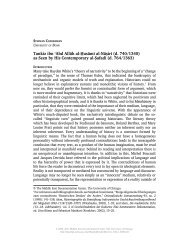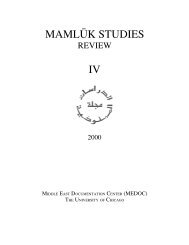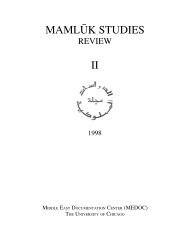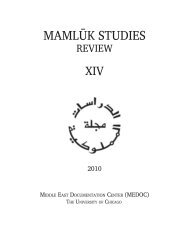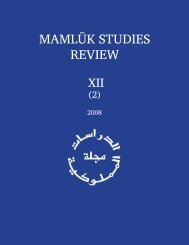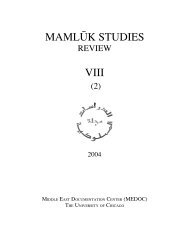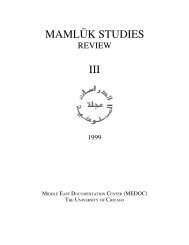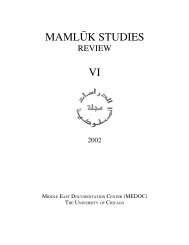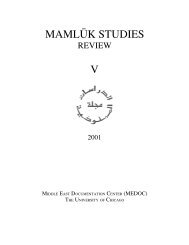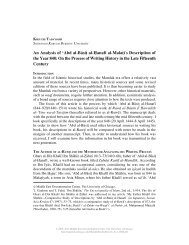Book Reviews (MSR XII.2, 2008) - Mamluk Studies Review ...
Book Reviews (MSR XII.2, 2008) - Mamluk Studies Review ...
Book Reviews (MSR XII.2, 2008) - Mamluk Studies Review ...
Create successful ePaper yourself
Turn your PDF publications into a flip-book with our unique Google optimized e-Paper software.
<strong>Book</strong> <strong><strong>Review</strong>s</strong><br />
TIMOTHY MAY, The Mongol Art of War: Chinggis Khan and the Mongol Military System<br />
(Yardley: Westholme, 2007). Pp. 214. Includes maps, illustrations, photographs,<br />
and glossary.<br />
REVIEWED BY PATRICK WING, University of Redlands<br />
Warfare and military conquest have long been associated with the Mongol Empire<br />
of Chinggis Khan in historical literature. We need only to consider the titles of<br />
works such as Juvaynī’s “History of the World Conqueror,” or Grigor of Akanc‘’s<br />
“History of the Nation of Archers” to realize that the earliest encounters between<br />
the Mongols and their Eurasian neighbors were essentially encounters with the<br />
Mongol army. In our own time, books such as J. J. Saunders’ The History of the<br />
Mongol Conquests and, more recently, Stephen Turnbull’s Genghis Khan and the<br />
Mongol Conquests, 1190-1400 have addressed the military aspects of the foundation<br />
and expansion of the Mongol Empire. However, for all the attention given to the<br />
Mongols as conquerors, there have been fewer attempts to provide a systematic and<br />
comprehensive overview of Mongol military organization, training, tactics, and<br />
leadership. 1 This is the goal of Timothy May’s The Mongol Art of War, a valuable<br />
contribution to our understanding of the structure of the Mongol military and<br />
the reasons for the Mongols’ success against almost all of their adversaries in the<br />
thirteenth century. For the readers of this journal, perhaps an even more pertinent<br />
question is why the Mongols were unable to conquer the <strong>Mamluk</strong> Sultanate, one<br />
for which May provides some insightful suggestions.<br />
After an introductory chapter providing a general overview of Chinggis Khan’s<br />
early life and career, as well as a narrative of the dynastic and political history<br />
of the Mongol Empire until the 1260s, May addresses several themes relating to<br />
the structure of the Mongol army. These include recruitment and organization,<br />
training and equipment, logistics and supply, espionage, tactics and strategy,<br />
and leadership. Two chapters discuss the Mongols’ major military opponents,<br />
including the Jürchen Chin, the empire of the Khwarazmshah, and the <strong>Mamluk</strong>s,<br />
as well as detailed accounts of specific campaigns and battles. A final chapter on<br />
the military legacy of the Mongols offers an assessment of the major strengths and<br />
weaknesses of the Mongol army, as well as an interesting summary of the ways in<br />
which Mongol tactics and strategy have impacted the history of warfare down to<br />
1 A general overview of Mongol military organization is provided by H. Desmond Martin, “The<br />
Mongol Army,” Journal of the Royal Asiatic Society (1943): 46–85.
232 BOOK REVIEWS<br />
the twentieth century.<br />
For the specialist, there are few new revelations about the details of the Mongols’<br />
campaigns. May relies on standard contemporary sources, including the Secret<br />
History of the Mongols, Juvaynī’s Tārīkh-i Jahān-gushāy, Nasawī’s Sīrat al-Sulṭān<br />
Jalāl al-Dīn Mankuburnī, Rashīd al-Dīn’s Jāmi‘ al-Tavārīkh, accounts of travelers<br />
from the Latin West, including Marco Polo, and many others. The value of this<br />
work is in the synthesis of the enormous amount of material relating to military<br />
matters in these sources, which enables the reader to comprehend the high degree<br />
of planning, organization, and strategy that accompanied the Mongols’ campaigns<br />
of conquest. Of particular value is the way in which the author illustrates the<br />
correlation between military organization, leadership, and mobility, a combination<br />
which accounts for the Mongols’ often overwhelming success on the battlefield.<br />
May illustrates how the keshik, the royal bodyguard of the khan, provided both a<br />
kind of military academy for Mongol commanders, as well as a proving ground<br />
where they could demonstrate their skill in the field while still under the control of<br />
the khan. Here May acknowledges the work of Thomas Allsen on the keshik as an<br />
institution of social control within the Mongol military and political system. 2 The<br />
experience gained in the keshik meant that when generals were given command<br />
of a mission, they came having had experience coordinating their actions with<br />
other units on the battlefield. Unlike many of their European enemies, Mongol<br />
commanders did not lead personal contingents, based on their own noble status.<br />
Instead, Mongol leadership was based on merit proven within the context of the<br />
royal bodyguard.<br />
The quality of leadership that the keshik provided became most valuable<br />
when it was translated into coordinated movement. Superior mobility combined<br />
with discipline were the major strengths of the Mongol army, according to May.<br />
Coordinated maneuvers of the Mongol horse archers made them deadly against<br />
armies in the field. Mongol weapons technology was also developed to enhance<br />
the advantages of the mounted archer. May provides a fascinating discussion of<br />
the superiority of the Mongol composite bow, which had a range far greater than<br />
the Frankish Crusader crossbow. The Mongols preferred to shoot their enemies at<br />
a distance, and to avoid close combat if possible. However, Mongolian practices<br />
like the nerge, or group hunt, could be employed to take advantage of coordinated<br />
cavalry movement. The enemy would be surrounded and forced to the center of<br />
a gradually contracting circle of warriors, in the same way that wild game on the<br />
steppe would be corralled during a hunt.<br />
May does address the <strong>Mamluk</strong> army, one of the few adversaries the Mongols<br />
could not conquer. The main reason for this was that the <strong>Mamluk</strong>s fought like<br />
2 Thomas T. Allsen, “Guard and Government in the Reign of the Grand Qan Möngke, 1251-1259,”<br />
Harvard Journal of Asiatic <strong>Studies</strong> 46 (1986): 495–521.
MAMLŪK STUDIES REVIEW VOL. 12, NO. 2, <strong>2008</strong> 233<br />
the Mongols did, and, man for man, they did it better. The <strong>Mamluk</strong>s represented<br />
an elite warrior caste, in which every individual was specifically chosen for<br />
specialized training and combat. The Mongols, on the other hand, while effective<br />
as a group, were individually not as talented as the <strong>Mamluk</strong>s in all areas of<br />
warfare. In a compelling analysis, May compares the <strong>Mamluk</strong>s to the Japanese<br />
samurai. Both the <strong>Mamluk</strong>s and the samurai were elite warriors who, unlike<br />
the knights of Europe, had mastered archery, a major strength of the Mongols.<br />
The <strong>Mamluk</strong>s’ main weakness was that they did not have as many horses as the<br />
Mongols, and thus could not compete with the Mongols’ mobility. However, the<br />
<strong>Mamluk</strong>s compensated for this by carrying out scorched earth measures on the<br />
Syrian frontier, thus denying the invading Mongols adequate pasture for their<br />
usual number of horses. With the mobility of the Mongols restricted, the <strong>Mamluk</strong>s’<br />
discipline and archery skill left little advantage to the Mongols in Syria.<br />
In the final chapter on the long-term legacy of Mongol warfare, the impact of the<br />
Mongols on the development of Muscovite and Russian tactics and organization is<br />
analyzed. The princes of Moscow emulated the Mongols, and borrowed institutions<br />
like the postal system (yam). May illustrates how enduring this experience was,<br />
pointing out that Mikhail Ivanin’s 1846 publication The Art of War of the Mongols<br />
and Central Asian Peoples continued to be part of Russian and Soviet military<br />
academy curriculum until World War II. May also discusses the relationship<br />
between Mongol tactics and the use of gunpowder weapons. Although the impact<br />
of the Mongols on the diffusion of gunpowder technology has been discussed<br />
before, May argues that the degree to which gunpowder weapons were developed<br />
in Eurasia was related to the degree of conflict particular states and societies had<br />
with the Mongols and other steppe nomads. Early cannons and firearms were<br />
effective against heavy artillery and infantry, as was widespread in Central and<br />
Western Europe, in a way they were not against steppe nomads. For this reason,<br />
May suggests, states sharing frontiers with the steppe saw less development in<br />
gunpowder weapons before the seventeenth century, when field artillery became<br />
mobile enough to counter the movements of nomad armies.<br />
The Mongol Art of War does not offer new interpretations of individual campaigns<br />
or battles, nor does it provide new perspectives on the familiar sources on which<br />
it relies. However, by providing a thorough, systematic analysis of several issues<br />
relating to the organization and projection of Mongol military power, Timothy<br />
May has produced a valuable contribution to our understanding of the Mongol<br />
Empire, its encounters with its neighbors and adversaries, and military history in<br />
general. For scholars of the <strong>Mamluk</strong> Sultanate, May’s treatment of the <strong>Mamluk</strong>s’<br />
military success against the Mongols is sure to stimulate positive discussion and<br />
debate within the field.
234 BOOK REVIEWS<br />
History and Historiography of Post-Mongol Central Asia and the Middle East: <strong>Studies</strong><br />
in Honor of John E. Woods. Edited by Judith Pfeiffer and Sholeh A. Quinn in<br />
collaboration with Ernest Tucker (Wiesbaden: Harrassowitz, 2006). Pp. 604,<br />
tables and index.<br />
REVIEWED BY THOMAS T. ALLSEN<br />
Like all such tributes to distinguished scholars, this volume collects essays from<br />
colleagues and former students, but unlike most endeavors of this sort, it has a<br />
“shape” which it sustains to a surprising degree. Thus, while many Festschriften<br />
are best described as “miscellanies,” covering diverse and disconnected topics,<br />
this celebration of Woods’ scholarly career takes on many of the attributes of a<br />
symposium volume arising from a research conference organized around a central<br />
theme, in this instance, Islamic historiography. The editors, contributors, and,<br />
ultimately, the honoree, deserve much credit for this uncommon result.<br />
Grouped under a variety of chronological and geographical headings, the first<br />
set of essays, despite the title, is devoted to “The Mongol World Empire.” Peter<br />
Jackson investigates their concept of a heavenly mandated universal dominion<br />
and concludes that it probably arose in the later stages of Chinggis Qan’s life as the<br />
unprecedented success of their imperial venture became apparent. He also makes<br />
the important point that alongside their claims of world dominion, the Mongols<br />
frequently tried to trick or cajole foes into submission and often downplayed their<br />
ideological pretensions in order to gain allies, divide enemies, or make temporary<br />
peace. To this end, they used a host of intermediaries-—subordinate princes,<br />
merchants, and translators—recruited from across Eurasia. All this is persuasively<br />
argued on the basis of both Muslim and Latin sources, of which the latter are<br />
particularly enlightening on the Mongols’ little-studied diplomatic techniques.<br />
In his contribution, Devin DeWeese notes that while the Mongols visited great<br />
destruction on the Islamic world, Sufi orders adapted well to the new order and<br />
extended their influence. While many Sufi narratives explain these gains through<br />
conversion tales involving shaykhs and qans, others put forward the rather<br />
unexpected claim that it was Sufi leaders’ guidance of Chinggis Qan that account<br />
for the success of the Mongols conquests, that is, God provided these alien forces<br />
with spiritual guides as a manifestation of his divine wrath, his disappointment<br />
with the failings of Muslim society. DeWeese points out, too, that such a narrative<br />
accords nicely with the Mongols’ strong attraction to “holy men” of all stripes.<br />
The early history of the Qongrat is carefully reconstructed by İsenbike Togan<br />
through a close analysis of Chinese and Persian sources and later tribal oral<br />
traditions. She finds that the Qongrat were divided into two major lineages, one<br />
in northeast Mongolia and another in the southeast abutting the agricultural lands
MAMLŪK STUDIES REVIEW VOL. 12, NO. 2, <strong>2008</strong> 235<br />
of the North China plain. The former, and most famous grouping, became allies<br />
and the consort clan of the Chinggisids, while the latter were later subdued by<br />
force. Her findings demonstrate the great potential of this kind of ethno-historical<br />
research for illuminating the past of the steppe zone.<br />
The next three offerings focus on Anatolia. The late Zeki Validi Togan explores<br />
the correspondence of Rashīd al-Dīn as a source of data on the region, noting that it<br />
contains statistics on all kinds of products and commodities, agricultural lands, and<br />
a variety of building projects. In his introduction, Gary Leiser, who translated the<br />
article from Turkish, succinctly summarizes the ongoing controversy concerning<br />
the authenticity of these letters and argues that some of their purely economic<br />
information might still be of value if handled critically. Hopefully, Togan’s article<br />
will stimulate further attempts to authenticate and retrieve specific categories of<br />
data embedded in the letters.<br />
Halil İnalcik takes a long view of “Autonomous Enclaves in Islamic States,”<br />
arguing that grants of royal land and immunity were characteristic of Muslim<br />
polities from the Abbasids to the Ottomans. Such enclaves originated in a<br />
number of bestowals—mulk, vaqf, soyurgal, etc.-—that not only transferred land<br />
to favored retainers, officials, and commanders, but also granted freedom from<br />
administrative interference and from taxes, the highly desirable tarkhan status.<br />
Over time, he concludes, these grants constituted a persistent force for political<br />
decentralization.<br />
Charles Melville investigates the principal Persian chronicles prepared in<br />
Anatolia during the late thirteenth and early fourteenth centuries, those of Ibn<br />
Bībī, Karīm al Dīn and the anonymous Tārīkh Āl-i Saljūq. He characterizes each, its<br />
sources, literary style, principles of organization, didactic purposes, and political<br />
allegiances. Lastly, he deftly situates these three sources into the larger framework<br />
of Ilkhanid historiography.<br />
The second letter of the Ilkhan Amad Tegüder to the <strong>Mamluk</strong> sultan Qalāwūn<br />
in 1283 is examined in Judith Pfeiffer’s article. She offers a detailed analysis<br />
of the context of their diplomatic exchanges and the first full translation and<br />
commentary on the letter in question. In so doing, she makes a substantial<br />
contribution to the interstate relations of the Mongolian era, which involved a<br />
multitude of players, and at the same time furthers our understanding of the<br />
internal history of Tegüder’s reign.<br />
The next section, “The Age of Timur,” the field most closely associated with<br />
Woods’ own interests and work, is well represented. Robert McChesney gives us an<br />
informative biographical study of Ibn ʿArabshāh, a major historian of the period,<br />
that reveals the sources of the author’s extreme dislike of the famed conqueror.<br />
At the same time his treatment of Ibn ʿArabshāh’s career richly illustrates the<br />
cosmopolitan and peripatetic nature of Muslim intellectual and cultural life in the
236 BOOK REVIEWS<br />
fifteenth century.<br />
Surprisingly, there are still parts of Babur’s manifold literary activities largely<br />
unexplored. Eiji Mano studies and compares Babur’s Chaghatay Turkish translation<br />
of the Vālidīyah, a Persian mystical text composed by Khwājah Aḥrār, the famed<br />
Naqshbandīyah shaykh. This affords an opportunity for an informative discussion<br />
of other extant works of the Sufi leader long thought lost.<br />
In another historiographical study, Beatrice Manz surveys fifteenth-century<br />
local chronicles of southern Iran, all by authors based in Yazd. She places the<br />
individual texts in their appropriate local and regional contexts, and identifies<br />
their sources of information, intended audiences, and ideological perspectives.<br />
Most impressively, she compares the chronicles written at Timurid courts with<br />
those from the south and shows that their discrepancies, no less than their areas<br />
of agreement, tell us much about the political dynamics between the center and<br />
the provinces.<br />
Paul Losensky presents a convincing case that although overshadowed by the<br />
literary fame of Timurid Herat, the Aqquyunlu court at Tabriz also collected its<br />
own luminaries in the fifteenth century. He focuses on the highly esteemed poetry<br />
of Shahīdī of Qum, who, so characteristic of his age, began his career in Herat,<br />
moved on to Tabriz, and ended his days in India.<br />
The next section, “The Safavids and their Legacy,” has a pronounced<br />
historiographical emphasis. One of the more important sources on the origins of<br />
this dynasty is Ṣafvat al-Ṣafā, a history of the eponymous founder of the Safavid<br />
Sufi order written by a lieutenant, Ibn-i Bazzāz. Michel Mazzaoui discusses the<br />
available manuscripts and the complicated history surrounding attempts to<br />
produce a critical edition, and gives an evaluation, largely positive, to a newly<br />
published (1995) edition from Ardabil. Sholeh Quinn traces the evolution of Safavid<br />
coronation ceremonies from their austere beginnings to their more elaborate<br />
manifestations in the seventeenth century. By comparing the differing emphases<br />
of the chronicles, she charts the changing notions of kingship and legitimacy,<br />
and identifies the mix of Islamic and Iranian elements in the ceremony. Camron<br />
Michael Amin looks at the coverage of Safavid history in official textbooks and<br />
public discussion in twentieth-century Iran. He finds that although the rhetorical<br />
and ideological contexts differed, both the Pahlavi regime and the Islamic Republic<br />
extolled the Safavids for their creation of a “modern” Iranian national identity<br />
and for fending off the encroachments of foreign invaders.<br />
In a somewhat different vein, Ernest Tucker studies the efforts of Nādir Shāh,<br />
the all-powerful Safavid general and founder of the Afshārid dynasty, to associate<br />
himself with Timur, who, faced with a similar situation, initially ruled through a<br />
series of Chinggisid figureheads. Nādir Shāh followed suit, found Safavid puppets<br />
and tried, unsuccessfully, to emulate Timur’s vast conquests. This is an intriguing
MAMLŪK STUDIES REVIEW VOL. 12, NO. 2, <strong>2008</strong> 237<br />
example of historical memory and of the role of “models” in empire building, for<br />
Timur himself took Chinggis Qan as his model and, like Nādir Shāh, was unable<br />
in the end to duplicate his predecessor’s record of expansion.<br />
The section on “Mamlūk <strong>Studies</strong>” begins with Anne Broadbridge’s revealing<br />
examination of the numerous apostasy trials held in Cairo in the late thirteenth<br />
and early fourteenth centuries, proceedings that shed considerable light on the<br />
relationship between the military and scholarly elites and on the <strong>Mamluk</strong> sultans’<br />
quest for legitimacy.<br />
Li Guo pursues the interesting theme of the use of verse in chronicle writing,<br />
particularly that of Ibn Dāniyāl, whose poems were widely cited and presented as<br />
accurate descriptions of contemporary events. This he did with some regularity,<br />
but his satirical verses on <strong>Mamluk</strong> anti-vice campaigns, as Guo demonstrates,<br />
were recycled and placed in differing chronological frameworks and in different<br />
literary forms. This recycling, he argues cogently, is in itself a useful source for<br />
cultural history.<br />
The annual maḥmal festival, held in Cairo during the month of Rajab, formally<br />
opened the <strong>Mamluk</strong>s’ pilgrimage to Mecca. But as John Meloy shows in his study<br />
of its origins and development, there was a sharp contrast between the institution’s<br />
“solemn intent” and its public reception, which transformed the event into a<br />
carnival-like celebration. The resultant tension provides a useful window on the<br />
dynamic relationship between governmental policy and popular culture.<br />
The famous pilgrimage of Mansa Mūsá, the ruler of Mali who passed through<br />
Cairo in 1324, is the subject of Warren Schultz’s contribution, which compares<br />
the depiction of this event in the Arabic sources with its conventional treatment<br />
in world history texts. He convincingly shows that the textbook perception that<br />
the Malian ruler’s gifts of gold were so vast that they depressed gold prices for<br />
decades is simply not true. What the sources do show is that his largesse produced<br />
one of the many short-term variations in the money market of medieval Cairo.<br />
In the shortest section, “Historical Geography,” the noted Persian scholar Īraj<br />
Afshār employs a close textual-philological approach to questions connected with<br />
the name and location of Damadan, a mountain mentioned in various sources<br />
from pre-Islamic times down to the Mongols. By way of methodological contrast,<br />
two Mongolian scholars, D. Bazargur and D. Enkhbayar, investigate, on the basis<br />
of toponymics and modern environmental studies, the geographical and natural<br />
worlds of the Secret History. Among their more interesting findings is that many<br />
migratory routes have been in continuous use since the days of Chinggis Qan.<br />
In the final section, “Interregional Contacts and Cross-cultural Transmission,”<br />
Abolala Soudavar examines the historiographical and publication activities of the<br />
Yuan Hanlin Academy, which he connects to similar efforts in the Ilkhan capital<br />
of Tabriz and to the rise of illustrated manuscript production in Iran. The Chinese
238 BOOK REVIEWS<br />
antecedents of this activity, expressed in official portraiture and book illustration,<br />
are well worth pursuing; such an investigation will need to take into account<br />
the vital importance of visual representation and its reproduction in the political<br />
culture of the Mongols and other steppe peoples.<br />
Muzaffar Alam and Sanjay Subrahmanyam analyze the variable views of two<br />
seventeenth-century Safavid travelers on India and the Indians. While some of<br />
their differences, they argue, are attributable to personal characteristics, a full<br />
explanation of their divergent images must also take into consideration internal<br />
developments within Mughal India.<br />
The spread of Persianate art to Istanbul is investigated by Fariba Zarinebaf-<br />
Shahr, who documents the importance of Tabriz as a cultural center and its<br />
influence on the Ottomans. This was exercised, in her view, through the forced<br />
removal of Tabrizi artists and artisans in the fifteenth and sixteenth centuries<br />
following successful Ottoman military operations. This fine study points up again<br />
the significance of this kind of “technician transfer” in the circulation of culture.<br />
The concluding essay by Douglas Streusand forcefully challenges H. A. R.<br />
Gibb’s view that Islam alone engendered Islamic civilization, thereby ignoring<br />
and minimizing its composite character, which drew upon both ancient Near<br />
Eastern, mainly Old Iranian, and Greek-Byzantine elements.<br />
Viewing the volume as a whole, and from the perspective of my own research<br />
interests, several other recurrent themes, besides that of historiography, emerge<br />
from this collective endeavor. First, is the peripatetic lives of so many artists and<br />
intellectuals; Muslim culture was highly mobile during the Chinggisid and Timurid<br />
eras. A second, and related, connecting thread is the importance of Tabriz, whose<br />
ample cultural resources were eagerly appropriated throughout this period by<br />
neighbors near and far.<br />
This brings us back to the honoree, whose first major contribution to the field<br />
dealt with the Aqquyunlu and their capital, Tabriz. Indeed this collection nicely<br />
mirrors Woods’ own research interests chronologically, geographically, and<br />
thematically, and many articles build upon and elaborate his work.<br />
Lastly, the overall quality of the papers is uniformly high; there are no learned<br />
notes here, only carefully argued papers based on primary research of a kind one<br />
would normally expect to find in a serious professional journal. And, as an added<br />
bonus, there is an extensive analytical index! In all respects, this is an uncommon<br />
Festschrift, one well earned.
MAMLŪK STUDIES REVIEW VOL. 12, NO. 2, <strong>2008</strong> 239<br />
ADAM SILVERSTEIN, Postal Systems in the Pre-Modern Islamic World (Cambridge:<br />
Cambridge University Press, 2007). Pp. 190.<br />
REVIEWED BY ELIZABETH URBAN, University of Chicago<br />
This impressive book is easily the most comprehensive work on the Islamic barīd<br />
to date. Temporally, it ends with the arrival of modern postal techniques, namely<br />
the telegraph and the privatization of postal systems in the sixteenth century.<br />
Spatially, it is confined to “those regions that were ‘Islamic’ throughout the<br />
formative and classical periods of Islamic history” (p. 3), which excludes most<br />
of Africa, southeast Asia, and Europe. Within these expansive parameters, the<br />
book is divided into three parts. Part One, “The pre-Islamic background,” deals<br />
mainly with the Roman cursus publicus, Persian postal systems as far back as the<br />
Achaemenid period, and the postal practices of pre-Islamic Arabia. Part Two,<br />
“Conquest and centralisation—the Arabs,” covers the Umayyads, the Abbasids<br />
along with several of their autonomous successor states, and the Fatimids. Finally,<br />
Part Three, “Conquest and centralisation—the Mongols,” includes the Il-Khan yām<br />
and <strong>Mamluk</strong> barīd. Throughout the book, Silverstein utilizes a staggering amount<br />
of primary and secondary source material, from Herodotus and the Babylonian<br />
Talmud to Islamic-era Greek papyri and studies on Chinese administrative history<br />
(though he of course did not consult every conceivable source, and this reviewer<br />
particularly noted the absence of such Syrian Islamic historians as Ibn ʿAsākir and<br />
Ibn al-Adīm).<br />
More crucial than the impressive amount of material that Silverstein has<br />
collected in this book, however, are the insightful questions he asks and useful<br />
analysis he provides. That is, the purpose of the book is not merely to amass data<br />
and dryly describe the minutiae of the barīd institution, but rather to provide<br />
answers to such questions as, “What (if anything) makes an Islamic postal system<br />
‘Islamic’?” (p. 4). Indeed, the greatest strength of this book lies in its examination<br />
of the way various dynasties adapted the barīd to their particular circumstances;<br />
instead of focusing on one dynasty, geographical area, or time period, Silverstein<br />
traces the developments of the barīd institution across various times and places.<br />
As he eloquently puts it, the relatively simple idea of the barīd “was expressed<br />
and elaborated upon in manifestly different ways throughout Islamic history. The<br />
idiosyncratic ways in which different states chose to interpret the basic postal<br />
formula offer us rare insights into the political traditions of particular dynasties<br />
and rulers” (p. 188). For example, Silverstein describes the changes that occurred<br />
within the Abbasid barīd network in the turbulent periods of Zanj and Qarāmiṭah<br />
revolts (pp. 111–21), and how both the Samanids and Ghaznavids simultaneously<br />
preserved and altered parts of the Abbasid barīd model (pp. 125–31). He does not
240 BOOK REVIEWS<br />
frame these changes in terms of Abbasid “decline,” but in terms of adapting to<br />
new circumstances.<br />
The readership of this journal will be most interested in the book’s fifth and<br />
shortest (at 22 pages) chapter, entitled “The <strong>Mamluk</strong> barīd.” Silverstein points out<br />
that the <strong>Mamluk</strong> barīd has received more scholarly attention than other Islamic<br />
postal systems, tipping his hat in particular to Jean Sauvaget’s masterpiece Poste<br />
aux cheveaux dans l’empire des Mamelouks. Silverstein’s work improves upon Poste<br />
aux cheveaux in two ways. First, he draws upon sources that were unavailable<br />
to Sauvaget, such as Baybars al-Manṣūrī al-Dawādār’s Zubdat al-Fikrah fī Tārīkh<br />
al-Hijrah and ‘Umar ibn Ibrāhīm al-Anṣarī’s Tafrīj al-Kurūb fī Tadbīr al-Ḥurūb.<br />
Secondly and more importantly, rather than attempting to supersede Sauvaget’s<br />
work in detail, Silverstein aims to “contextualise the <strong>Mamluk</strong> Barīd in relation<br />
to previous and contemporary postal systems, a subject in which Sauvaget was<br />
uninterested” (p. 167, n. 12). He achieves this goal through a discerning comparison<br />
of the postal systems in <strong>Mamluk</strong>, Abbasid, Fatimid, and Il-Khan domains. First,<br />
he analyzes the very origins of the <strong>Mamluk</strong> barīd, asking why Baybars would<br />
have wanted to create a barīd given that the Fatimids and Ayyubids before him<br />
had thrived without one. Then, while acknowledging the significant impact of<br />
the Il-Khan yām on the <strong>Mamluk</strong> postal system (an idea first noted by Sauvaget<br />
and taken up by other scholars such as Gazagnadou), Silverstein also examines<br />
the ways the <strong>Mamluk</strong> barīd drew on models other than the yām. He notes that<br />
the <strong>Mamluk</strong> system differed from the Il-Khan system in several important ways,<br />
that the <strong>Mamluk</strong>s inherited political traditions from many sources aside from<br />
the Mongols, and that the <strong>Mamluk</strong>s themselves consciously (or self-consciously)<br />
attributed their barīd to the Abbasid caliphal model. Examining this claim of<br />
Abbasid legitimacy, Silverstein also details how the <strong>Mamluk</strong> barīd was distinct<br />
from the Abbasid model. Finally, Silverstein sees the decline of the <strong>Mamluk</strong><br />
barīd in light of the peace achieved between the <strong>Mamluk</strong>s and Mongols in the<br />
fourteenth century, as well as the reforms instituted by al-Nāṣir Muḥammad. As a<br />
whole, Silverstein’s assessment of the <strong>Mamluk</strong> barīd is enlightening and carefully<br />
argued. However, he does very occasionally verge on oversimplification or even<br />
cultural bias; a superficial reading of the book might lead some readers to think the<br />
<strong>Mamluk</strong>s were military machines who could not maintain a purely bureaucratic<br />
institution, or that ethnic Turks were better suited to horsemanship than anything<br />
else (see especially p. 169). In the end, his analysis of the <strong>Mamluk</strong> barīd is actually<br />
much more nuanced than any pre-conditioned understanding of the <strong>Mamluk</strong>s<br />
would permit, and these seemingly biased statements are often the result of blithe<br />
phrasing rather than misconception.<br />
Unfortunately, there is one noticeable gap in the book’s attempt to contextualize<br />
the <strong>Mamluk</strong> postal system. Silverstein mentions that the <strong>Mamluk</strong> barīd may have
MAMLŪK STUDIES REVIEW VOL. 12, NO. 2, <strong>2008</strong> 241<br />
been influenced by the Golden Horde (p. 185), a statement which he cannot<br />
elaborate upon because he does not include the Golden Horde’s postal system<br />
in this book. This is partially justifiable, as the Golden Horde falls outside the<br />
parameters set in the Introduction; however, in this case the chosen parameters<br />
seem more cumbersome than helpful. It is understandable that Silverstein had to<br />
draw his limits somewhere, but to cover the Il-Khans and the <strong>Mamluk</strong>s but not<br />
the Golden Horde seems unwise given the close (if not always friendly) contact<br />
between those three states.<br />
As a final note, readers will be pleased with the book’s flowing style and<br />
engaging mixture of primary source quotation and ensuing analysis. However,<br />
it does occasionally suffer from lack of clarity. For instance, when Silverstein<br />
claims that the Il-Khan barīd “became an ‘Islamic’ postal system” within a few<br />
decades of Hülegü’s conquering Iran and Iraq (p. 153), he gives no immediate<br />
indication of what he means by this. This omission is especially frustrating as<br />
one of the stated goals in the Introduction is to discover what makes an Islamic<br />
postal system “Islamic.” Eventually, Silverstein does explain the meaning of<br />
this statement, but it is not until the Conclusion of the book more than thirty<br />
pages later. Other examples of unclear writing could be cited, but in general his<br />
narrative is quite lively and readable. In the end, no amount of nitpicking about<br />
the occasional missed source or unclear sentence can decrease the importance of<br />
this book. Students of Islamic administrative history, whether or not they focus on<br />
the <strong>Mamluk</strong> period, will benefit greatly from Silverstein’s perceptive analysis and<br />
fruitful comparisons of Islamic barīd systems throughout the pre-Modern period.



